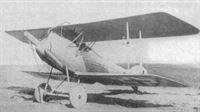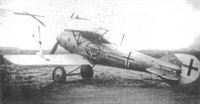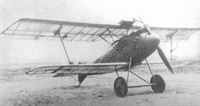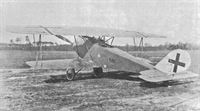
Описание
Страна: Германия
Год: 1918
Fighter
Варианты
- LFG Roland - D.VI - 1918 - Германия
- LFG Roland - D.VII - 1918 - Германия
- LFG Roland - D.XIII/D.XV - 1918 - Германия
- O.Thetford, P.Gray German Aircraft of the First World War (Putnam)
- W.Green, G.Swanborough The Complete Book of Fighters
- J.Herris Roland Aircraft of WWI (A Centennial Perspective on Great War Airplanes 9)
-
W.Green, G.Swanborough - The Complete Book of Fighters
Based on the D VII, the single D XIII had the experimental Korting Vee-type engine.
-
J.Herris - Roland Aircraft of WWI /Centennial Perspective/ (9)
The Roland D.XIII fighter prototype was similar to the earlier D.VI, D.VII, and D.VIII prototypes, but used the experimental 195 hp Korting Kg.III V-8. Failure of this engine doomed the Roland D.XIII.
-
M.Dusing - German Aviation Industry in WWI. Volume 2 /Centennial Perspective/ (85)
LFG tested the Korting Kg IIIa in its Roland D.XIII.
-
M.Dusing - German Aviation Industry in WWI. Volume 2 /Centennial Perspective/ (85)
The Roland D.XIII fighter prototype was similar to the earlier D.VI, D.VII, and D.VIII prototypes, but used a different engine, the experimental 195 hp Korting Kg.III V-8.This engine failed to reach production, dooming the D.XIII.
-
O.Thetford, P.Gray - German Aircraft of the First World War /Putnam/
L.F.G. Roland D XIII
-
J.Herris - Roland Aircraft of WWI /Centennial Perspective/ (9)
The first Roland D.XV prototype, 3004/18, was powered by a production 170 hp Mercedes D.IIIa engine. It used the Klinkerrumpf fuselage construction, had parallel interplane struts, and was clearly related to the production D.VIa.
-
J.Herris - Roland Aircraft of WWI /Centennial Perspective/ (9)
Additional view of the first Roland D.XV prototype, 3004/18, which was powered by a production 170 hp Mercedes D.IIIa engine. Its Klinkerrumpf fuselage construction and overall design was clearly similar to the Roland D.VIa already in production; the key difference is that the D.XV eliminated bracing wires and their associated drag.
-
J.Herris - Roland Aircraft of WWI /Centennial Perspective/ (9)
L.F.G. Roland D XV (first version)
-
J.Herris - Roland Aircraft of WWI /Centennial Perspective/ (9)
L.F.G. Roland D XV (first version)
-
J.Herris - Roland Aircraft of WWI /Centennial Perspective/ (9)
The second Roland D.XV prototype, 3006/18, was the 2,000th aircraft built by Roland and was painted to celebrate this achievement. Appearing in June 1918, the second prototype had single-bay I-struts but was otherwise similar to the first prototype. It was tested with both a production 170 hp Mercedes D.IIIa engine and a 185 hp BMW.IIIa. It was fairly fast but had insufficient climb rate, and as a result, in September 1918 Idflieg demanded still further modifications to the prototypes.
-
O.Thetford, P.Gray - German Aircraft of the First World War /Putnam/
L.F.G. Roland D XV (second version)
-
J.Herris - Roland Aircraft of WWI /Centennial Perspective/ (9)
Another view of the second Roland D.XV prototype, 3006/18. Tested with both a 170 hp Mercedes D.IIIa engine and a 185 hp BMW.IIIa engine, it was fairly fast but its climb rate was not sufficient. The distinctive radiator design and location differ from previous Roland practice.
-
Jane's All The World Aircraft 1919 /Jane's/
An Experimental Roland Type D.XV Single-seater Biplane. (160 h.p. Mercedes engine.) This machine was the 2,000th aircraft turned out by the Roland factory.
-
J.Herris - Roland Aircraft of WWI /Centennial Perspective/ (9)
Retaining the D XV designation, a wholly new design was produced late in 1918.
-
M.Dusing - German Aviation Industry in WWI. Volume 1 /Centennial Perspective/ (84)
Roland D.XV prototype with BMW IIIa engine (1918)
The third Roland D.XV prototype was a completely new design that abandoned Roland's Klinkerrumpf fuselage construction in favor of a plywood fuselage. It retained the distinctive radiator design and location introduced on the previous Roland D.XV prototypes; other than the radiator it closely resembled the reigning Fokker D.VII. -
J.Herris - Roland Aircraft of WWI /Centennial Perspective/ (9)
The completely new third Roland D.XV prototype closely resembled the dominant Fokker D.VII, which was certainly not a coincidence. The fact that Roland ignored Idflieg demands to continue modifications to the first two D.XV prototypes may have been due to Roland's realization that neither prototype could compete with the Fokker D.VII regardless of modifications. Two new 'D.XV' aircraft were built, the first was rolled out in late October and was powered by a 185 hp BMW.IIIa.The second was completed soon after and was powered by a 200 hp Benz Bz.IIIa. Neither prototype was in time for the Third Fighter Competition and the Armistice halted further development.
-
Jane's All The World Aircraft 1919 /Jane's/
A Roland Single-seater "Wireless" Biplane. Type D.XV in third prototype form. (190 h.p. B.M.W. engine.)
-
J.Herris - Roland Aircraft of WWI /Centennial Perspective/ (9)
L.F.G. Roland D XV (fourth version)
O.Thetford, P.Gray German Aircraft of the First World War (Putnam)
L.F.G. Roland D XIII
Next in the long series of Roland prototypes was the D XIII serialled 3002/18, there being no record of D X, XI or XII. This was little more than the second version of the D VII with a 195 h.p. Korting vee-eight engine with reduction gearing. Span, 9 0 m. (29 ft. 6 3/8 in.). Area, 23 sq.m. (248 sq.ft.). Armament, twin Spandau machine-guns.
L.F.G. Roland D XV (first version)
As the first of four D XV prototypes, No. 3004/18 still perpetuated the use of clinker-built fuselage first used on the D IV. The wings had no bracing cables and considerably more stagger than any of the previous prototypes which probably improved forward and downward visibility from the cockpit, but omission of centre-section cut-out could not have given very good upward and forward field of view. Engine, 160 h.p. Mercedes D III. Span, 8.64 m. (28 ft. 4 1/4 in.). Area, 23.8 sq.m. (257 sq.ft.). Weights: Empty, 730 kg. (1,606 lb.). Loaded, 910 kg. (2,002 lb.). Armament, twin Spandau machine-guns.
L.F.G. Roland D XV (second version)
The second D XV prototype. No. 3006/18, was basically a D VI airframe with a new wing cellule braced solely with single I-struts, no cables being used. The top wing was of greater chord while the chord of the lower wing was considerably reduced. This was the last of the Roland fighter series to feature the clinker-planked fuselage. Engine, 180 h.p. Mercedes D IIIa. Span, 9.0 m. (29 ft. 6 3/8 in.). Area, 23 sq.m. (248 sq.ft.). Armament, twin Spandau machine-guns.
L.F.G. Roland D XV (third version)
The third and fourth versions of the D XV were alike except for engine installation. In construction they were very different to their precursors, slab-sided plywood-covered fuselages being used and the wings braced with tubular steel "N" struts. There were no flying or landing wires bracing the wing cellule. This model is said to have been a copy of the Fokker D VII, which may or may not be true. Certainly it was no slavish although a certain similarity of outline must be admitted. Engine, 185 h.p. B.M.W. III (third version), 200 h.p. Benz Bz IIIa V (fourth version). Armament, twin Spandau machine-guns.
Описание:























